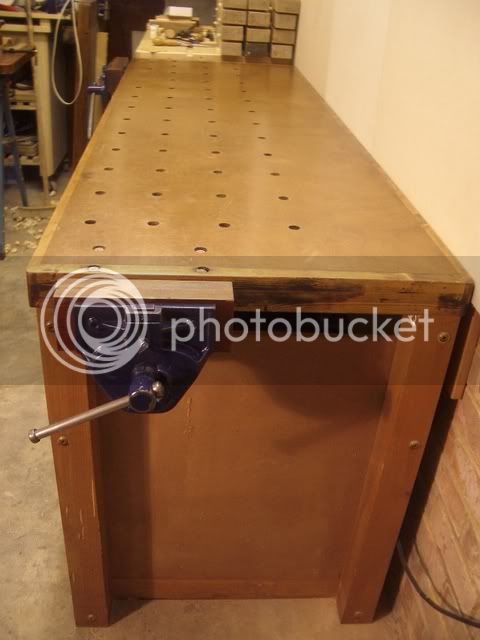BigShot
Established Member
Hi folks,
Well, the time has finally come to start planning my first workbench. There's one rather hefty drawback though, I don't have any real budget to speak of.
I do, however, have a nearly limitless supply of free MDF in (roughly) 1200x800 sheets. It's mostly about 15-18mm thick. It comes from a kitchen manufacturer which would rather give it away than sling it.
Apart from the logistics (it's first come, first served... no reservations... no idea what they actually have in stock till you get there... but whatever you can carry away is yours... and it's about a 15 minute drive away) it struck me that this might be the perfect way to get a bench together on my practically-zero budget.
Herein lie the questions.
If I was to cut 15mm MDF into 90mmx1200mm strips and then glue and clamp 6 strips together to make a 6-ply 90mmx90mmx1200mm block - would that be suitable to use as a leg for the bench? (Repeat 3 times for a complete set, of course.)
Is there anything I would need do to other than gluing face to face? Biscuits? Dowels? Screws? Obviously I wouldn't want the bits to start coming apart at any point so if anything is needed to improve the integrity of the legs I would like to do that.
My "workshop" is the garage, and there will be some humidity issues in there until I find the funds for a dehumidifier - will I need to seal the MDF in any way? If so, what with?
Finally, if I do glue up MDF in this way, is it then likely to be suitable for traditional joints like mortise and tenons, half laps and dowel techniques like drawbore?
(I don't want to give the impression I'm in anyway experienced with woodworking by using those terms, I know what they are but have made a grand total of ZERO joints using them... well, there were some half laps on a rubber band powered plane I made from a kit as a kid - but I'm not counting that here.)
I'm not really concerned with looks, though I do think well made, sturdy things tend to look quite good almost by default, but I do want something functional.
A flat, stable surface to work on, a decent size, storage underneath for grinders, bench drill, maybe a table saw... things like that.
I'm not so much asking about plans here (though if someone has any suggestions I'll be glad to hear them - I'll be using the bench to make furniture, shelves, a desk or two, and garden stuff such as planters and the likes) as I'm asking about the sense in using MDF like that.
I look forwards to any responses you come up with.
Cheers folks.
Well, the time has finally come to start planning my first workbench. There's one rather hefty drawback though, I don't have any real budget to speak of.
I do, however, have a nearly limitless supply of free MDF in (roughly) 1200x800 sheets. It's mostly about 15-18mm thick. It comes from a kitchen manufacturer which would rather give it away than sling it.
Apart from the logistics (it's first come, first served... no reservations... no idea what they actually have in stock till you get there... but whatever you can carry away is yours... and it's about a 15 minute drive away) it struck me that this might be the perfect way to get a bench together on my practically-zero budget.
Herein lie the questions.
If I was to cut 15mm MDF into 90mmx1200mm strips and then glue and clamp 6 strips together to make a 6-ply 90mmx90mmx1200mm block - would that be suitable to use as a leg for the bench? (Repeat 3 times for a complete set, of course.)
Is there anything I would need do to other than gluing face to face? Biscuits? Dowels? Screws? Obviously I wouldn't want the bits to start coming apart at any point so if anything is needed to improve the integrity of the legs I would like to do that.
My "workshop" is the garage, and there will be some humidity issues in there until I find the funds for a dehumidifier - will I need to seal the MDF in any way? If so, what with?
Finally, if I do glue up MDF in this way, is it then likely to be suitable for traditional joints like mortise and tenons, half laps and dowel techniques like drawbore?
(I don't want to give the impression I'm in anyway experienced with woodworking by using those terms, I know what they are but have made a grand total of ZERO joints using them... well, there were some half laps on a rubber band powered plane I made from a kit as a kid - but I'm not counting that here.)
I'm not really concerned with looks, though I do think well made, sturdy things tend to look quite good almost by default, but I do want something functional.
A flat, stable surface to work on, a decent size, storage underneath for grinders, bench drill, maybe a table saw... things like that.
I'm not so much asking about plans here (though if someone has any suggestions I'll be glad to hear them - I'll be using the bench to make furniture, shelves, a desk or two, and garden stuff such as planters and the likes) as I'm asking about the sense in using MDF like that.
I look forwards to any responses you come up with.
Cheers folks.






